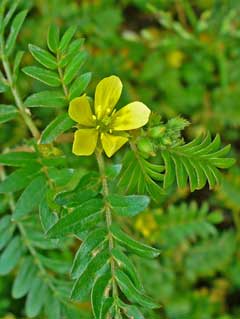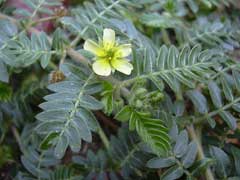 |
|
commons.wikimedia.org/wiki/User:Llez |
 |
| www.hear.org/starr/ |
Translate this page:
Summary
Physical Characteristics

 Tribulus terrestris is a ANNUAL/BIENNIAL growing to 0.6 m (2ft) at a fast rate.
Tribulus terrestris is a ANNUAL/BIENNIAL growing to 0.6 m (2ft) at a fast rate.
It is frost tender. It is in flower from April to August. The species is hermaphrodite (has both male and female organs).
Suitable for: light (sandy), medium (loamy) and heavy (clay) soils and prefers well-drained soil. Suitable pH: mildly acid, neutral and basic (mildly alkaline) soils. It cannot grow in the shade. It prefers dry or moist soil. The plant can tolerate maritime exposure.
UK Hardiness Map
US Hardiness Map
Synonyms
Plant Habitats
Cultivated Beds;
Edible Uses
Edible Parts: Fruit Leaves Shoots
Edible Uses:
Leaves and young shoots - cooked[144, 177]. A nutritional analysis is available[218]. Fruit - cooked. The unexpanded seed capsules are ground into a powder and made into a bread[2, 144, 177, 179]. A famine food, it is only used when all else fails[2].
References More on Edible Uses
| Composition
|
| Figures in grams (g) or miligrams (mg) per 100g of food.
|
|
|
Leaves (Fresh weight)
|
|
- 0 Calories per 100g
- Water : 79.09%
- Protein: 7.22g; Fat: 0g; Carbohydrate: 0g; Fibre: 0g; Ash: 4.6g;
- Minerals - Calcium: 1600mg; Phosphorus: 80mg; Iron: 9.22mg; Magnesium: 0mg; Sodium: 0mg; Potassium: 0mg; Zinc: 0mg;
- Vitamins - A: 0mg; Thiamine (B1): 0mg; Riboflavin (B2): 0mg; Niacin: 0mg; B6: 0mg; C: 41mg;
- Reference: [ 218]
- Notes:
|
|
Medicinal Uses
Plants For A Future can not take any responsibility for any adverse effects from the use of plants. Always seek advice from a professional before using a plant medicinally.
Abortifacient Alterative Anthelmintic Aphrodisiac Carminative Demulcent Diuretic Galactogogue
Infertility Leprosy Pectoral
The seed is abortifacient, alterative, anthelmintic, aphrodisiac, astringent, carminative, demulcent, diuretic, emmenagogue, galactogogue, pectoral and tonic[4, 147, 176, 178, 218]. It stimulates blood circulation[147]. A decoction is used in treating impotency in males, nocturnal emissions, gonorrhoea and incontinence of urine[4, 240]. It has also proved effective in treating painful urination, gout and kidney diseases[240]. The plant has shown anticancer activity[218]. The flowers are used in the treatment of leprosy[218]. The stems are used in the treatment of scabious skin diseases and psoriasis[218]. The dried and concocted fruits are used in the treatment of congestion, gas, headache, liver, ophthalmia and stomatitis[218].
References More on Medicinal Uses
The Bookshop: Edible Plant Books
Our Latest books on Perennial Plants For Food Forests and Permaculture Gardens in paperback or digital formats.

Edible Tropical Plants
Food Forest Plants for Hotter Conditions: 250+ Plants For Tropical Food Forests & Permaculture Gardens.
More

Edible Temperate Plants
Plants for Your Food Forest: 500 Plants for Temperate Food Forests & Permaculture Gardens.
More

More Books
PFAF have eight books available in paperback and digital formats. Browse the shop for more information.
Shop Now
Other Uses
References More on Other Uses
Cultivation details
We have very little information on this species and are not sure how successful it will be in Britain. There are conflicting reports on its hardiness - according to one report it is native to N. France which should make it hardy in Britain[50] whilst another report says that it is only hardy in zone 10 which means that it is not frost tolerant[200]. We would suggest treating it as a frost tender annual and then experimenting with its hardiness. It is likely to require a well-drained dry to moist soil and is also likely to be tolerant of maritime exposure. The plant is very fast growing from seed[50]. A good bee plant[156].
References Carbon Farming Information and Carbon Sequestration Information
Temperature Converter
Type a value in the Celsius field to convert the value to Fahrenheit:
Fahrenheit:
The PFAF Bookshop
Plants For A Future have a number of books available in paperback and digital form. Book titles include Edible Plants, Edible Perennials, Edible Trees,Edible Shrubs, Woodland Gardening, and Temperate Food Forest Plants. Our new book is Food Forest Plants For Hotter Conditions (Tropical and Sub-Tropical).
Shop Now
Plant Propagation
Seed - sow spring in a greenhouse. When they are large enough to handle, prick the seedlings out into individual pots and plant them out after the last expected frost.
Other Names
If available other names are mentioned here
Native Range
TEMPERATE ASIA: Kuwait, Saudi Arabia, Afghanistan, Cyprus, Egypt (Sinai), Iran, Iraq, Israel, Jordan, Lebanon, Syria, Turkey, Russian Federation-Ciscaucasia (Ciscaucasia), Armenia, Azerbaijan, Georgia, Russian Federation-Western Siberia (Western Siberia (southeast)), Kazakhstan, Kyrgyzstan, Tajikistan, Turkmenistan, Uzbekistan, Mongolia, China, Japan TROPICAL ASIA: India, Pakistan AUSTRALASIA: Australia (north) EUROPE: Austria, Hungary, Slovakia, Russian Federation-European part (European part (south)), Moldova, Ukraine (incl. Krym), Albania, Bulgaria, Greece (incl. Crete), Croatia, Italy (incl. Sardinia, Sicily), Romania, Slovenia, Spain (incl. Baleares), France (incl. Corsica), Portugal AFRICA: Spain (Canarias), Algeria, Egypt, Libya, Morocco, Tunisia, Somalia, Kenya, Tanzania, Uganda, Cameroon, Democratic Republic of the Congo, Gabon, Benin, Ghana, Mali, Niger, Nigeria, Senegal, Togo, Mozambique, Malawi, Zambia, Zimbabwe, Botswana, Lesotho, Namibia, Eswatini, South Africa, Madagascar
Weed Potential
Right plant wrong place. We are currently updating this section.
Please note that a plant may be invasive in one area but may not in your area so it's worth checking.
Conservation Status
IUCN Red List of Threatened Plants Status :

Growth: S = slow M = medium F = fast. Soil: L = light (sandy) M = medium H = heavy (clay). pH: A = acid N = neutral B = basic (alkaline). Shade: F = full shade S = semi-shade N = no shade. Moisture: D = dry M = Moist We = wet Wa = water.
Now available:
Food Forest Plants for Mediterranean Conditions
350+ Perennial Plants For Mediterranean and Drier Food Forests and Permaculture Gardens.
[Paperback and eBook]
This is the third in Plants For A Future's series of plant guides for food forests tailored to
specific climate zones. Following volumes on temperate and tropical ecosystems, this book focuses
on species suited to Mediterranean conditions—regions with hot, dry summers and cool, wet winters,
often facing the added challenge of climate change.
Read More
Expert comment
Author
L.
Botanical References
50200
Links / References
For a list of references used on this page please go here
Readers comment